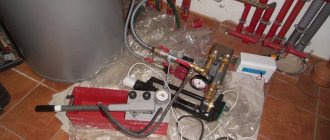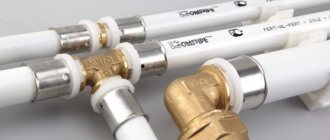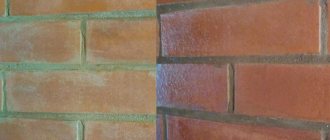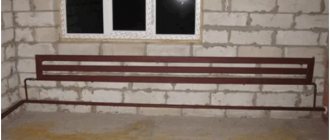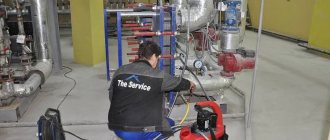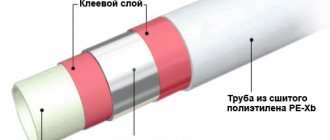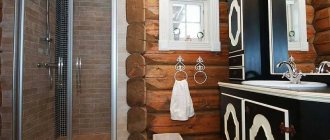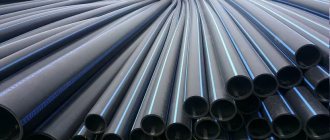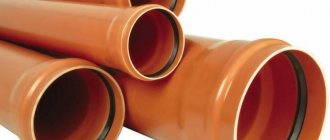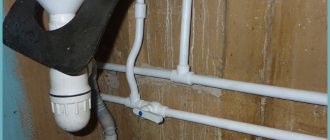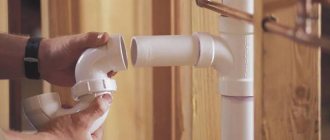Select products by parameters
Products:5
DefaultPriceRating
Manual press pliers used for working with metal-plastic pipes are designed to connect pipelines together using press fittings. Such connecting elements differ from threaded analogues by the presence of a sleeve instead of a nut.
The tightness of the connection is ensured by crimping a pipe placed on a fitting and inserted inside a metal sleeve. It is this sleeve that is compressed by the press pliers. The pressed area should not be re-exposed to mites, as this may break its tightness.
What parameters characterize press jaws?
Before you buy press pliers for metal-plastic pipes, it is advisable to familiarize yourself with their main parameters. In this case, you can make the right choice of tool:
The diameter of the pipes is maximum, which can be subjected to crimping.
This data is available in the passport that comes with the tool. A rotating unit on which replaceable attachments are attached. Its presence makes working in hard-to-reach places more convenient. Tool life. This is the minimum number of crimps produced by the pliers over the entire service period. The telescopic handles of the pliers make it possible to change the length of the lever, which is very convenient when crimping large diameter pipes. Vespress pliers.
The ease of use and mobility of the tool depends on this parameter. Types of press attachments. Some models of pliers are only suitable for working with fittings from certain companies. Before you decide to buy press pliers for metal-plastic pipes, find out what fittings you will have to work with.
Preparatory measures for crimping
Before starting crimping work, you must perform the following steps:
- The pipeline system under test is inspected for obvious defects (missing elements, rusted areas, etc.). Identified violations are eliminated. If the system is filled with any substance that cannot be used for testing, for example, coolant in a heating system, it must be emptied.
- Next, according to the rules, the pipeline is flushed. This operation will remove scale, rust, and organic and inorganic deposits from the pipes. Flushing can be carried out in various ways, some of which require the use of a compressor. According to the rules, upon completion of this procedure, the quality of its implementation should be checked by cutting out a section 0.5 m long in an arbitrary place of the pipeline and assessing the condition of its internal surface.
- The preparatory stage ends with the installation of a check valve and a pressure gauge, if they are not part of the injection device. A check valve is necessary to retain the working medium in the system.
When testing heating systems of apartment buildings, work on preparing the heating unit is carried out separately from the entire system and after it. This is due to the fact that this unit is tested with a higher pressure value.
How to use manual press jaws
By spreading the handles of the pliers, the halves of the press insert, the diameter of which corresponds to the diameter of the pipe, are inserted into the holder. The clip snaps into place and is considered ready for use. A metal-plastic pipe with a sleeve is inserted into it, which is already connected to the fitting.
The handles of the press pliers close on the sleeve, squeezing it with a certain force. Marks from the liner remain on the surface of the sleeve, indicating that the installation was carried out correctly. Re-compression of the connection is not allowed.
Price
The cost of crimping depends on several factors:
- length (internal volume) of the system;
- the age of the system and the condition of its constituent elements (amount of rust and dirt and salt deposits);
- type of equipment used.
Prices from different performers, even within the same city, may differ by 2–3 times. Private teams and craftsmen charge the cheapest for their services.
On average, for flushing and pressure testing the heating system of a building with an area of 400 sq. m (two-story) performers charge from 7 to 15 thousand rubles. As practice has shown, if you know how to bargain, you can agree to complete this amount of work for 4–5 thousand rubles. The work will be completed in 1 – 2 days.
The same work in a building of 5 thousand square meters. m (5 floors) will cost from 30 to 80 thousand rubles.
Some performers indicate prices per unit of volume (150 - 250 rubles / cubic meter) or time (500 - 1000 rubles / hour).
If you want to install the washbasin yourself, be sure to take care of connecting the water seal. Water seal for sewerage: types, purpose and installation features.
You will learn about the types of antiseptics for cesspools in this review.
How to choose pliers for metal-plastic pipes
When choosing a suitable model of pliers, pay attention to the following points:
Cost of ticks. A tool designed for manual use has always been cheaper than an electric or battery-powered option. At the same time, the quality of the connections will be no worse than when using the most sophisticated model. Nowadays, almost all press jaws are capable of working with small diameters, which characterize metal-plastic pipes.
If you have to crimp pipes of significant diameters, then inquire about the working range of the pliers. The pliers can work with smaller diameters due to the presence of replaceable attachments. It is recommended to buy pliers that come with sets of replaceable inserts. By doing so, you will expand the range of your work.
If you really like a particular model, but there are no replacement attachments included, then purchase them separately. Just make sure that they fit your press jaws. With a small difference in cost, a tool produced by well-known companies specializing in this will be much more durable and stronger. The following manufacturers of hand press tools have proven themselves to be excellent: REMS, Hydrosta, VALTEC, Rothenberger, FORA, Novopress.
You can select and buy press pliers for metal-plastic pipes by contacting the Eurotools store.
In our offices located in Krasnodar, Moscow and St. Petersburg, you can get professional advice and choose the right tool model. Our store's website, email and phone number are also at your service. A system of personal discounts, a wide selection of tools and affordable prices will leave you in no doubt about choosing a store.
Gifts for products in this section
Personal recommendations
All productsSelect storeDisplay:Sort by: PopularityRatingAscending priceDecreasing priceDisplay by: 204080productsUseful information
Press pliers are designed for crimping terminals and connecting wires. They allow you to quickly and efficiently lay wiring. Necessary for technical equipment of companies providing electrical installation services, energy departments at enterprises, public utilities, and private craftsmen.
Crimping machines, pumps for crimping pipes
First of all, the pumps used for pressure testing differ in the design of the discharge mechanism.
On this basis they are divided into the following groups:
- Piston.
- Vane-rotor.
- Membrane.
For crimping systems with a small volume, for example, heating circuits in private homes, you can purchase an inexpensive and easy-to-maintain manual crimping machine.
Using such a device, the operator will be able to pump up to 3 liters of working fluid per minute into the pipeline. For a multi-storey building, this option, of course, will be unacceptable; here you will need a crimping machine with an electric or internal combustion engine drive.
The most popular is the domestically produced manual crimping machine UGO-30, designed for a maximum pressure of 30 atm. The cylinder volume is 36 cubic meters. cm, force on the handle – 2 kg. Equipped with a 16 liter tank.
For more serious tasks, manual two-stage pumps UGO-50 (up to 50 atm) and UGI-450 (up to 450 atm) are intended.
Manual hydraulic crimping machine UGO 30
Among electric crimpers, units from the German company Rothenberger are known, for example, the self-priming model RP PRO II, which develops a pressure of 60 atm and a flow of 8 l/min. The drive power is 1.6 kW.
Ridgid products are also highly rated, for example, model 1460-E. This crimping machine develops pressure up to 40 atm.
The autonomous water supply system will operate uninterruptedly only if the pressure switch for the hydraulic accumulator is correctly configured. Let's consider the principle of operation and the procedure for adjusting the relay.
Read how to make a drainage well with your own hands here.
Who doesn't dream of a swimming pool in their country house? Such a custom-made design will be expensive, but you can save money and build a pool yourself. Here https://aquacomm.ru/vodosnabzenie/zagorodnyie-doma-v/bassejn-na-dache-svoimi-rukami.html you will find instructions for building a concrete reservoir.
Types of equipment and principle of operation
There are hydraulic and mechanical manual press pliers for crimping. The former require less physical effort from the operator and allow for greater developed force, and therefore are ideal for frequent use in various production conditions. For rare use, it is more advisable to purchase mechanical press pliers - they are cheaper.
Hydraulic equipment is divided into several types. Non-autonomous models require connection to a pump; autonomous models are more convenient, as they can be used without additional equipment. Hand press pliers with a remote pump are great for working in hard-to-reach places.
There are special press pliers for fittings - equipment designed for crimping the connecting parts of various pipelines.
Main characteristics
- Crimping area – selected with a margin based on the maximum diameter of the cable and tip that will be used. The price of manual press pliers depends on it. Working stroke – indicates the minimum and maximum size of cables for crimping. Developed force – determines the capabilities of the equipment: the larger it is, the better the quality of crimping.
Manufacturers
Top
Down
Metal-plastic pipes are widely used in plumbing systems, as well as in heat supply. These parts are able to withstand various aggressive environments, so their use is widespread, along with similar elements made of polypropylene materials, not only in residential premises, but also in industrial enterprises, during the distillation of petroleum products, and so on. When installing systems, it is necessary to carry out a set of operations to test the pipeline system, called crimping, in which a press tool for metal-plastic pipes is used. Metal-plastic pipes can withstand various aggressive environments, so their use is widespread. Purpose of the crimping operation Crimping of metal-plastic pipes allows you to check the level of tightness and endurance of these parts in any system. This operation is carried out during installation, as well as during emergency replacement of some heating sections (boilers, radiators or small parts of pipes).
Pressure testing allows you to identify leaks or defects in the entire system. In this case, you can use free-plan heating system projects, for example, with pipes running in the floor. As a rule, in such premises a concrete coating is used, and the screed is carried out after a pressure test. Installation of metal-plastic and polypropylene pipes is carried out using special devices - fittings.
They are fasteners or assemblies (angles, tees, couplings, plugs and other elements). Fittings are fastened when connecting polypropylene pipes using a welding machine. There are two types of these fasteners: crimp and press fittings. The first type is named after the connection method - crimping the pipes together.
This method is easier to implement, but the connection is fragile. Conditions for installing pipes and crimping Installation of metal-plastic and polypropylene pipes is carried out using special devices - fittings. During installation work, the following conditions must be observed: Installation of parts made of metal-plastic, as opposed to polypropylene pipes, the connection of which must be carried out at least +5°C, is usually carried out at a temperature not lower than +10°C; When pressing, defects (concavity or breakage) must not be allowed to occur. If they are present, it is necessary to replace the pipe section; When laying pipes, it is necessary to avoid the occurrence of tensile stress; The open ends of the parts must be closed with special plugs to avoid the ingress of debris or dirt; The concrete floor covering is poured after testing, and the pressure in the pipes should be equal to 0.3 MPa. Correctly carried out installation work on metal-plastic pipes and polypropylene elements can ensure a service life of the entire system of more than 50 years. To perform crimping, use the following equipment and tools: cutter or pipe cutter; calibrator for stripping and leveling the end edge; press fittings of the required diameter; press tool (manual or electric). Press tool or pressure tester is a unit whose main element is a hydraulic pump. This part sets the pressure value that is necessary for proper crimping of pipes. There are two types of pressing tools: Manual pressing tool.
This tool is mainly used for small-scale work and in areas where there is no access to power. A hand tool requires some effort to press, which is a disadvantage in using this type of device; Electric tool. This device is used for large volumes of work.
It has a number of advantages: easy to operate, reliable and durable. The procedure for installing metal-plastic pipes with a press tool is as follows: A manual crimping machine is used mainly for small-volume work and in areas where there is no access to power. Preparing and checking the fitting and pipes. In this case, the metal-plastic part must be cut at a right angle. The edges of the end part must be cleaned using a calibrator, the chamfer from the inside of the pipe must be removed. The fitting (pipe with a threaded connection) must be checked according to several parameters, having previously lubricated it with a soap solution or silicone grease. Check whether the fitting is seated correctly.
If the seal rings are not in the intended grooves, you must remove the sleeve using a regular screwdriver. Then install the rings correctly and put the sleeve back on, making a few gentle blows with a hammer on the socket. Connect the fitting fitting to the crimping tool, and if you use a hand tool, then you need to bend the “jaws” of the device and connect it to the sleeve so that the special recess in the nozzle, which the manual crimper has, came into contact with the restrictive edge. This can be observed through a special window in the sleeve. The crimper must be at right angles to the axis of the fitting sleeve.
The pressing process is carried out until the “jaws” of the tool are completely closed. It is important to take into account that the operation of the electrical device is 2 minutes, and the rest period is at least 8 minutes. The pressure testing procedure is necessary during installation work of heating and plumbing systems, as well as during seasonal inspections and emergency repairs of individual sections of the pipeline. In this case, a special device is used - a press tool for metal-plastic products, which allows you to identify various defects when installing systems. Share a useful article: Similar articles:
Press pliers for metal-plastic pipes are included in the line of mandatory tools, without which it is impossible to install a metal-plastic pipeline. For example, to work with copper systems you will need a tool such as a soldering iron, and to lay steel gauges you will need a welding machine. Likewise, laying a metal-plastic (MP) network is impossible without pliers.
MP systems are used very often. These designs boast durability and reliability. They comply with all hygiene and operational standards.
But, all this is possible only if the installation and installation work is carried out in accordance with the technology. One of the important factors in its compliance is the use of special tools, which also include pliers.
The crimping press for laying metal-plastic assortments is manufactured by most manufacturers not only in a standard version, but also in a unified and professional version. These are the following types of devices.
- hydraulic devices;
- electrical machines equipped with a set of various clamps.
It is clear that a home craftsman will not need such a crimping mechanism.
For one-time work, a hand tool is quite suitable for him. By the way, it should be noted that professional equipment costs much more. Also, using a professional crimping device requires certain knowledge and skills from the master.
IMPORTANT! Professional craftsmen claim that the quality of the joint, which is made with a manual crimping mechanism, is not inferior in reliability to the joint made with an electric device.
Thus, we can come to the conclusion that if the amount of work is not large and is carried out one-time, there is no point in buying expensive professional tools.
Speaking about hand pliers, professional craftsmen highlight tools from Novopress from German manufacturers. Each such mechanism is equipped with a fast reverse motion, has a compact size, and is distinguished by a consistently high level of quality.
And for heavy loads, Rems pipe tools are recommended. This equipment is manufactured by stamping from solid steel blanks, and is equipped with step-type clamps. They will not only withstand high loads, but will also serve for a long period of time.
Methods for crimping metal-plastic
The hydraulic method involves filling metal-plastic pipes with water and then increasing the pressure to set values. Tests may affect the entire installed highway or only individual sections of it.
The pneumatic method uses compressed air instead of water. This crimping method is considered less effective and more dangerous compared to the hydraulic option. And it doesn’t matter whether metal or metal-plastic pipes are tested.
Image gallery
Photo from
Construction of a metal-plastic pipeline
Pressure testing of a gas pipeline
Metal-plastic pipes in the installation of heated floors
Metal-plastic pipes in high-rise buildings
Option #1: hydraulic
The process is no different from the standard version, which is used on steel water mains. The only caveat is that the operating pressures for plastic pipes are lower than those accepted for metal products.
Accordingly, the test pressure is calculated taking into account standard operating pressure settings for plastic according to the formula:
Ri = Ррп * 1.5,
In it, Ri is the test pressure; Ррп – working pressure of a plastic pipe.
The water temperature inside the pipeline is allowed within positive values of 5 - 40ºС.
Progress of the procedure:
- Prepare the test area (install taps, plugs).
- Install 2 pressure gauges at different points in the line.
- Install an air vent at the upper level of the pipeline.
- Connect the water pump at the lower level of the line.
- Fill the line with water supply from the lower level to the upper level.
- Open the air vent to bleed air from the system.
Inside the pipeline made of metal-plastic pipes, the pressure should be increased slowly, excluding sudden jumps. Such pressure pumping conditions are provided by a manual hydraulic press.
A hydraulic pump is used to test an assembled or repaired system that requires perfect tightness of connections. The connections themselves are not formed using the pump.
Until the pressure value approaches the operating level, it is recommended to periodically visually monitor areas of possible leaks.
These areas are usually:
- pipe-in-pipe connections;
- contact between pipe and fitting;
- installation points for taps and plugs.
Increasing the pressure inside metal-plastic pipes to a value exceeding the operating parameter by 1.5 times is allowed only in the absence of people near the tested line.
The established test pressure inside the pipeline must be maintained for a certain time. For water supply systems made of metal-plastic pipes designed for use in domestic conditions, a five-minute minimum holding period is adopted.
During the accepted minimum test time, a pressure drop at the installation points of control pressure gauges is not allowed. When negative changes are observed on control instruments, this condition indicates incomplete tightness of the system.
The pressure should be reduced to the operating value and carefully checked for possible leaks throughout the entire section of metal-plastic pipes. Eliminate detected defects and repeat the test procedure.
At the final stage of crimping metal-plastic pipes, the pump is disconnected from the system. Also remove control pressure gauges, previously installed plugs and shut-off valves
Leak tests are passed when they satisfy the following conditions:
- no leaks were visually detected;
- no pipe wall ruptures were visually detected;
- for five minutes there were no changes in pressure on the control pressure gauges;
- there are no visible deformations of the pipelines.
Meanwhile, it is necessary to clarify: if the time delay exceeds a five-minute interval, a slight drop in test pressure is allowed due to a natural change in the temperature of the water inside the metal-plastic pipes.
Option #2: pneumatic
If it is impossible to carry out hydraulic pressure testing for some reason, an alternative is allowed - pneumatic testing.
The pneumatic test method differs in a slightly different way of checking for leaks, but in general it practically repeats the hydraulic method. This technology is not used so often on pipes, but it is widely used for crimping individual devices, such as expansion tanks, boilers, heat exchangers, etc.
A convenient, small-sized and lightweight automobile air pump is quite suitable for performing pneumatic tests of a home plumbing system on metal-plastic pipes
To detect leaks under pneumatic pressure testing, a soap solution is usually used. The assembled line is filled with air under pressure Pu = Ppp * 1.15 and areas of potential leaks are irrigated with a soap solution. The release of air is determined by the swelling of bubbles.
This testing technique allows you to visually detect even minor leaks. But it is quite difficult for the inspector to monitor the presence of leaks in places that are difficult to reach for visual observation.
The pneumatic test method is quite suitable for testing the tightness of connections between metal-plastic pipes using fittings or using the “pipe-in-pipe” scheme. But when you need to test the strength of a pipeline system, this method is clearly not the best. Here it is necessary to resort to hydraulic testing.
What fitting is used for the press
When assembling the main parts, components are used - these are adapters, collet and press fittings (which are the most reliable and practical). With the help of such devices you can get a high-quality and durable joint.
It is very important to choose the right press jaws. The easiest to use are hand-held devices.
They are distinguished by their simple design. A press coupling for a metal-plastic pipe can be easily connected with this device. Even an inexperienced master can cope with this task.
The range of this type of coupling for crimping metal-plastic pipes is very large, which makes it possible to carry out wiring of any level of complexity. And the combined coupling allows you to connect not only metal-plastic, but also steel lines.
Also speaking about shaped elements, it should be noted that the press coupling allows you to reduce the amount of assortment and fittings used.
When purchasing a pressing coupling for an MP network, you should not skimp on it. Purchasing a product from a dubious manufacturer may result in subsequent expensive system repairs.
Technical parameters of the instrumentation
Before purchasing a press for installing metal-plastic pipes, it is necessary to study in detail the main parameters and characteristics of the equipment. These include:
Range of crimping diameters. Types of shaped elements for installation.
Some tools can only crimp certain manufacturers' fittings. The type of circuit that performs the crimping. The purpose of the model is indicated by a specific letter when marking. By looking at the profile view, you can determine the purpose of the model for installation. Handle length.
Any novice craftsman will be interested to know that this factor affects the cost of the device. The thing is that when crimping fittings with pliers with small handles, you need to put in more physical effort. Resource capabilities of pliers. This includes the amount of fitting crimp that the press can produce.
The ease of operation depends on this indicator. Equipped with a rotating mechanism into which replaceable attachments for pliers are attached. This addition to the tool makes it possible to crimp fittings on a vertical pipeline. Manufacturer. This factor largely affects cost and quality.
Watch the video
In order for the fittings to be crimped efficiently, you need to perform the following steps.
Place a removable ring at the connection point, which is intended for crimping fittings for a specific type and volume of pipe. Calibrate the line while simultaneously chamfering.
At this stage of installation, a calibrator will be needed. Then the end part of the pipe and the fitting are combined. Often, special holes are provided on the fittings; they allow you to control the position of the pipe part. Using press pliers, the fittings are crimped, which requires some effort. The quality of crimping is checked by the grooves formed; their appearance indicates the strength of the connection. The joint is checked for strength level.
IMPORTANT! Pressure testing of fittings can be done once. When this work is repeated, the connecting parts become unusable and cannot be repaired.
SNiP
Data on the procedure for performing pressure testing of pipelines, technological diagrams of this process and safety precautions are contained in the relevant sections of the following SNiPs:
- SNiP 3.05.01-85 (dedicated to internal sanitary systems).
- SNiP 41-01-2003 (outlines the issues of organizing heating, air conditioning and ventilation systems).
- SNiP 3.05.04-85 (applies to external drainage systems).
The method of pressure testing of pipelines of industrial enterprises is specified in industry standards.
Among other things, these documents establish the value of the test pressure. It depends on the material of the pipeline, the thickness of its walls (the minimum value is taken), the difference in height between the uppermost and lower elements of the system and other factors. Most often, the pressure during hydropneumatic tests is developed to the following values:
- in pressure pipelines (water supply): 10 – 15 atm.;
- cast iron sewerage: 1.5 atm.;
- non-pressure polymer pipes: 1.5 – 2 atm.;
- heating systems in apartment buildings (with cast iron radiators): 2 – 5 atm. (according to SNiP - at least 1.5 working pressure);
- input node (in centralized systems): 10 atm.;
When pressure testing a heating system in private homes, a pressure of up to 2 atm is sufficient. (there is no point in pumping higher: the emergency valve is usually set to this level).
Mini pliers
A mini press designed for metal-plastic pipes is a small-sized device that provides manual crimping of the coupling. These mini pliers are used for highways with a volume of 16 to 20 mm. These mechanisms are complemented by sets of nozzles with a TN profile.
Mini pliers are not equipped with telescopic handles, so you will have to put in more effort when working. The compression force in such devices is 10.5 kN.
Without attachments, the mini device weighs no more than two and a half kilograms. The handles on these pliers are often covered with PVC material, and the axial eccentrics on mini pliers make it possible to make adjustments when excessive play occurs.
Professional craftsmen highlight the quality of small-sized devices from VALTEC. These manufacturers offer not only high-quality mini crimping pliers, but also threading tools, scissors, and other tools for installation work.
All the pros and cons of using pressing equipment
As is clear from the information presented, it is necessary to use presses for metal-plastic pipes. Without them, it is impossible to fasten the MP line with a press coupling.
They are indispensable for work when you need to install taps, install a heating network or install heated floors. Now it’s time to summarize all the positive and negative aspects of this connection method.
- The pressing connection is one-piece and does not require constant tightening and monitoring. Connecting metal-plastic pipes with fittings using presses allows you to install a line in a concrete screed, and any other hidden types of installation. The connection made with pressing pliers easily works under pressure up to ten bar. Press connections connections are characterized by mechanical strength and durability. They can stand for more than 50 years. Simple installation, performed by presses, is not labor-intensive and is completed in a short time.
But connections that involve pressing equipment also have some disadvantages. These include:
- the system becomes not dismountable, and errors when installing press joints are fraught with subsequent cutting of pipes and installation of a new fitting; the cost of presses for many home craftsmen is significant, so this toolkit is not widely popular among this category of craftsmen.
Pressure testing with air and water - what is it?
The essence of pressure testing is to fill a certain system with a closed volume - a pipeline, container, machine or mechanism - or its isolated section with a medium whose pressure is 2 - 3 times higher than the working one and almost corresponds to the maximum permissible value (the value of the test pressure for each specific case is set by the appropriate norms).
If the object passes this test, it is considered suitable for use.
Otherwise, places where the system has leaked are identified and repaired.
To create the required pressure, either a special pump for pressure testing pipelines, the so-called pressure tester, or a standard one, for example, a circulation pump in a centralized heating system, is used.
Water is usually used as a working medium, but if for one reason or another its penetration outside the tested system is unacceptable, pressure testing is carried out with air. In this case, leak locations are more difficult to detect.
Pressure testing is a fairly serious undertaking and must be carried out by a specially trained, certified employee. For municipal and industrial enterprises this rule is mandatory.
Upon completion of the procedure, a Certificate of hydropneumatic testing of the system (pressure testing of the pipeline) is signed, indicating the date, pressure value, holding time and other information.
As for private housing, the decision here is in the hands of the homeowner. Many people undertake crimping on their own, but it is still better to entrust this work to a professional.
Instrumentation with electrohydraulics
Watch the video
The battery press, used for metal-plastic pipes, is one of the electro-hydraulic tools. This also includes networked and universal machines.
As a rule, a device with a battery is a small-sized mechanism that is light in weight. But, if you compare a battery-powered device and devices that do not run on electricity, the first one is distinguished by high performance and ease of use. A battery-powered device is used to process highways with a diameter of no more than 110 mm.
Any rechargeable model operates on a battery. These mechanisms use only universal pressing heads that are suitable for specific sizes of metal-plastic pipes.
IMPORTANT! The battery pack can perform approximately fifty to one hundred compressions per charge cycle.
Instructions for use
Regardless of the type of installation and equipment you choose, there is a general procedure for preparatory work. These rules will facilitate the construction of the pipeline and are advisable to follow:
- you need to draw up a pipe routing plan, this will help calculate the amount of material and couplings;
- work areas must be thoroughly cleaned to prevent dust and dirt from entering the connection points in order to avoid leaks in the future;
- if you need to connect to an existing system, you need to check its integrity and prepare the insertion site;
- pipes should be cut so that the cut is exactly 90 degrees to the longitudinal axis of the pipe, this is necessary to ensure reliability and tightness;
- Guided by the diagram, lay out all the pipes and couplings to check the cutting and the quantity of all the necessary connection elements.
As mentioned above, there are three main options for joining cross-linked polyethylene. The selection of equipment and tools depends on the choice of method. For all methods you will need nozzles for the diameter of the pipes and pruning shears.
The first method is the easiest to implement. In addition to pipes and pruning shears, you only need compression couplings and a pair of wrenches. These tools are needed to tighten the nuts after fitting them to the joint.
It is important to remember: you need to control the process of tightening the nuts so as not to damage the threads. You need to tighten it tightly, but do not overtighten.
The second method is pressing. You will need a calibrator, scissors, an expander and a press.
There will be no difficulties with scissors; their purpose is simple - to cut the pipe into the sizes we need. We process its edges with a calibrator, chamfering it from the inside. This tool is necessary to give the pipe a rounded shape after cutting.
Then we take a manual expander, which is very easy to use. We deepen the working edges of the device inside the pipe and expand it to the desired size. This should not be done at once, as this can damage the material. We do this gradually, turning the expander in a circle. The advantages of this device are its price and ease of use. This is an amateur instrument.
The electrically powered expander is equipped with a battery and is designed to speed up the work of the installer. It significantly saves the worker’s effort and time for installing systems. Naturally, this device is many times more expensive, but if a lot of work is required, it is perfect and will justify the cost. There are hydraulic expanders. After we prepare the pipe, you need to install the fitting into it. For this we need a press vice. They are also hydraulic and mechanical. Before use, they must be removed from the storage case and assembled into working position.
After assembling the tool and installing the coupling into the pipe, the connection is installed using a press. That is, the fitting fits into place, and crimping occurs on top with a mounting sleeve. Manual presses are recommended for use with small pipe diameters and low demand.
Hydraulic presses require virtually no effort during crimping. Simply install the fittings and sleeve into the groove on the device, then they slide into place easily and smoothly. This tool can be used even in places that are inconvenient for installation; it has a rotating head. And the last option for connecting cross-linked polyethylene is welded. As mentioned earlier, it is the most expensive and rarely used, but the most reliable. In addition to the already familiar scissors and expanders, it will also require special couplings. Electric welding fittings have special conductors for heating.
After preparing the equipment and components, we begin welding. To do this, we install an electric welded coupling at the end of the pipe. It has special terminals to which we connect the welding machine. We turn it on, at this time all the elements warm up to the melting point of polyethylene, about 170 degrees Celsius. The coupling material fills all voids and welding occurs.
If the device is not equipped with a timer and a device that can read information from the fittings, you need to monitor the instrument readings in order to turn everything off in time. We turn off the equipment, or it turns off on its own, and wait until the unit cools down. Very often, pipes are supplied in reels and may lose their shape during storage. This is why you need a hair dryer. With its help, it is possible to eliminate this drawback by simply heating the deformed section with warm air.
In the next video you will find an overview of tools for installing heating and water supply systems made of cross-linked polyethylene.
